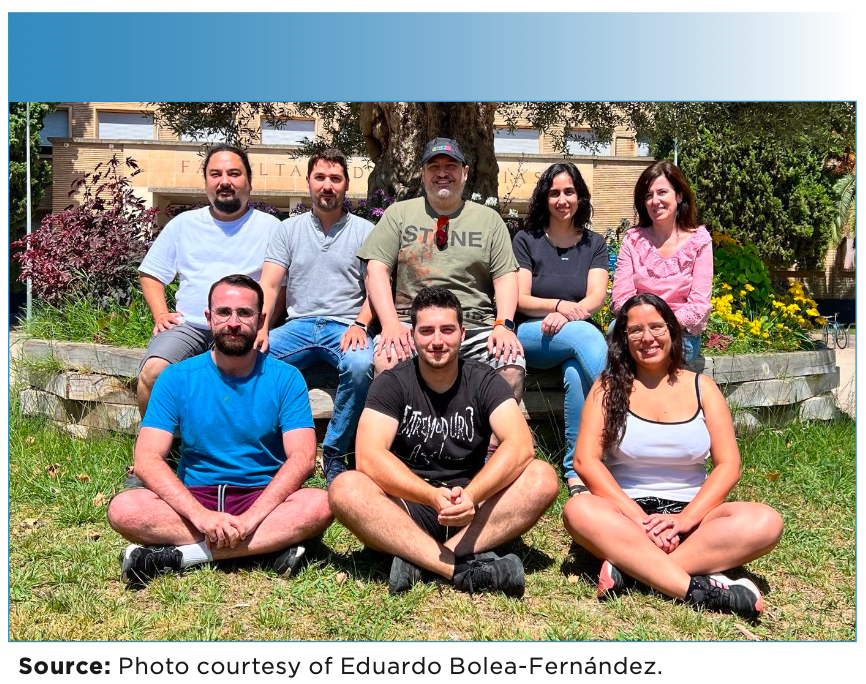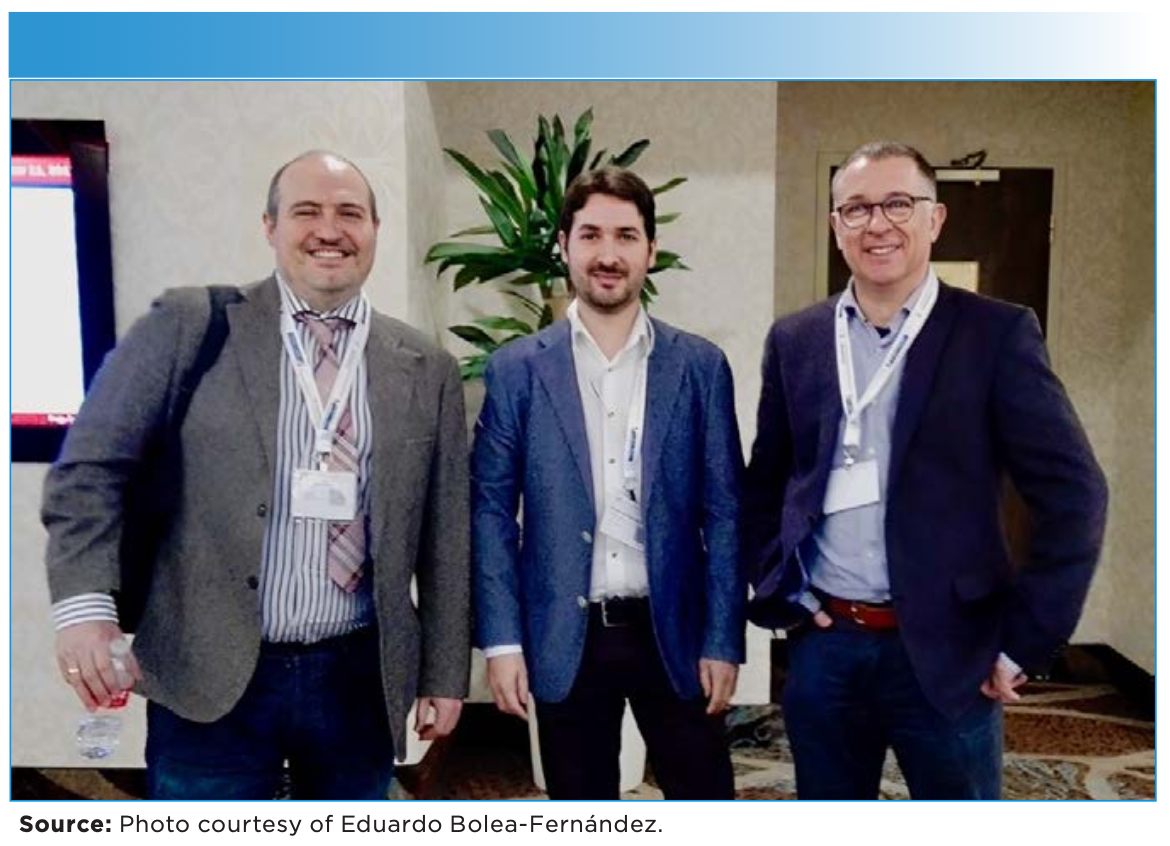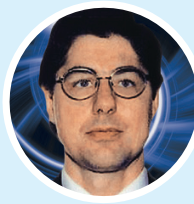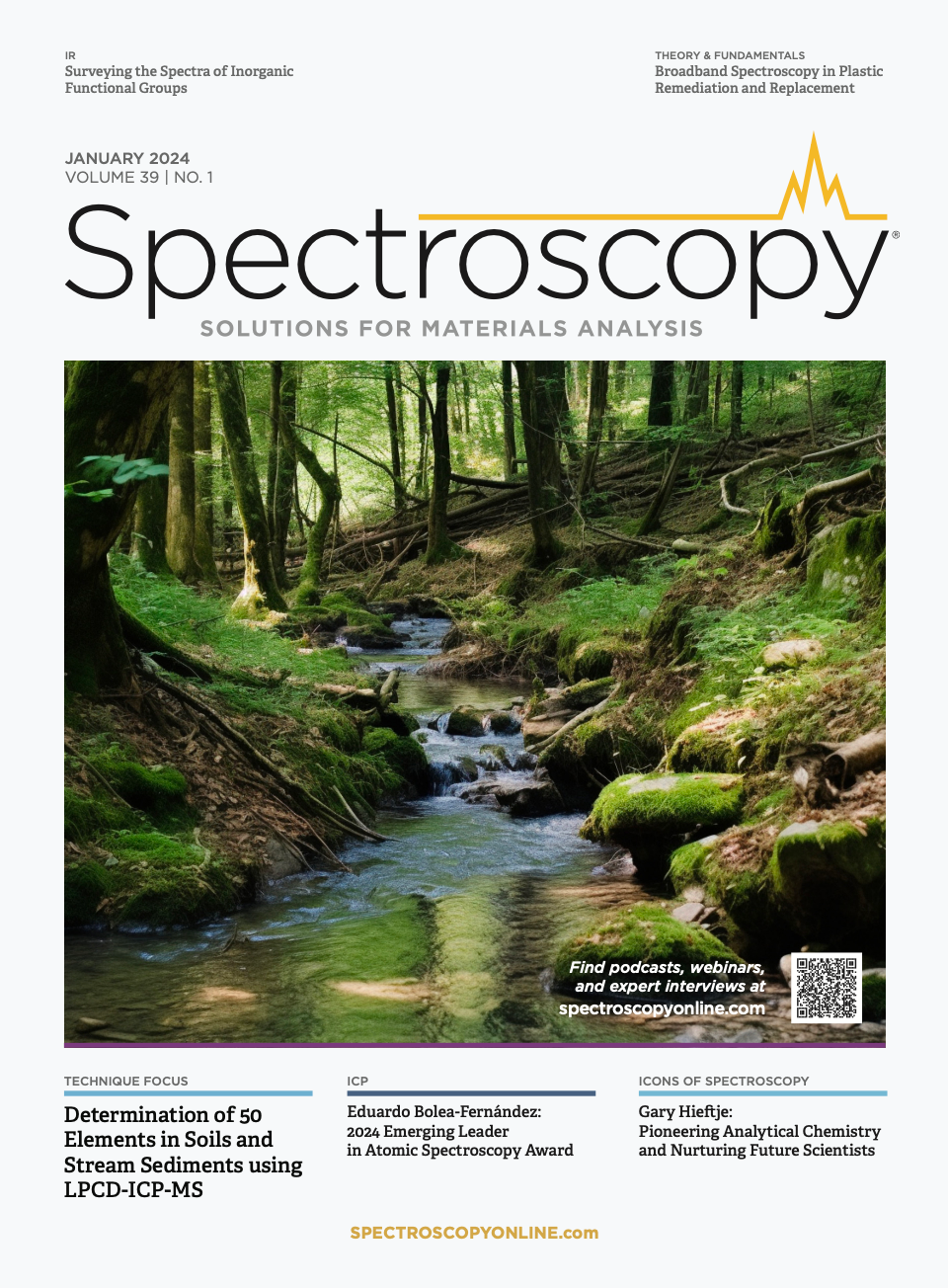The 2024 Emerging Leader in Atomic Spectroscopy Award
This year’s Emerging Leader in Atomic Spectroscopy Award recipient is Eduardo Bolea-Fernández. For the past decade, Bolea-Fernández’s research has focused on the development of a newly introduced technique, termed tandem ICP-mass spectrometry (ICP-MS/MS), for ultra-trace elemental and isotopic analysis. He has also worked on the topic of high-precision isotopic analysis of mercury (Hg) using cold-vapor generation multi-collector ICP-MS instrumentation. His most recent work involves research in the context of single-event ICP-MS, a novel method of ICP-MS operation enabling the characterization of nanoparticles and individual cells. Moreover, he demonstrated for the first time ever that this approach can also be used for the characterization of microplastics by relying on their carbon content, a topic that is receiving significant attention.
Eduardo Bolea-Fernándezof the Department of Analytical Chemistry at the MARTE research unit of the University of Zaragoza in Spain has won the 2024 Emerging Leader in Atomic Spectroscopy Award, which is presented by Spectroscopy magazine. This annual award, begun in 2017, recognizes the achievements and aspirations of a talented young atomic spectroscopist, selected by an independent scientific committee. The award will be presented to Bolea-Fernández at the 2024 USA Winter Conference on Plasma Spectrochemistry (in Tucson, Arizona on January 15–21, 2024), where he will give an award lecture.
Eduardo Bolea-Fernández

Bolea-Fernández’s research has focused on the development of fundamental measurement methodologies in the context of metallomics and nanotechnology, especially focusing on the use of the temporally and spatially resolved (multi-)element information obtained using different ICP-MS instrument configurations.
“In our research, ICP-mass spectrometry is at the center and can be considered the core of our activities. We apply high-end method development to address various scientific questions from an interdisciplinary perspective,” Bolea-Fernández said.
Bolea-Fernández obtained his bachelor’s and master’s degrees in chemistry at the University of Zaragoza in Spain in 2012. He then completed his PhD research at Ghent University in Belgium, supervised by Frank Vanhaecke, PhD, (leader of the A&MS group), Lieve Balcaen, PhD, and Martin Resano, PhD, and obtained his PhD degree in chemistry in 2017. His doctoral research was on the development of tandem inductively coupled plasma-mass spectrometry (ICP-MS/MS), for ultra-trace elemental and isotopic analysis. This research resulted in a significant number of scientific publications and has led to his international reputation as an emerging expert in ICP-MS analysis.
A Decorated Career
Bolea-Fernández is currently serving as a Ramón y Cajal (RyC) contract holder at the Department of Analytical Chemistry in the MARTE research unit at the University of Zaragoza in Spain. His academic journey began with his work specializing in atomic and mass spectrometry. Throughout his career, he has held various research positions at Ghent University in Belgium, actively participating in research projects funded by the Research Foundation - Flanders (FWO) and the Research Council of Ghent University.
His research efforts have resulted in 47 scientific publications in peer-reviewed international journals, including Analytical Chemistry, Environmental Sciences, Materials Science, Multidisciplinary Sciences, Nanoscience & Nanotechnology, and Spectroscopy. He has also presented his research at more than 50 international conferences, including several invited or keynote lectures. He also serves as a reviewer for leading journals in analytical chemistry, spectroscopy, and environmental science.
His work has been recognized with awards such as the Young Investigator Award in Plasma Spectrochemistry in 2022 (at the Winter Conference on Plasma Spectrochemistry), and the 2018 IUPAC-Solvay International Award for Young Chemists, highlighting the impact of his early research in plasma spectrochemistry.
Bolea-Fernández is also dedicated to student mentorship. He supervises both PhD and master’s students, and provides guidance on Bachelor-level projects. He also participates in academic service, serving on the examination board for PhD defenses and external assessment for theses (Autonomous University of Madrid, Ghent University, University of Alicante, University of Zaragoza, and University of Gerona).
As a committed academician, Bolea-Fernández continues to inspire the scientific community with his research and dedication to advancing analytical chemistry and spectroscopy, and his ongoing work holds promise for further advancements in these areas.
Notable Research
Bolea-Fernández’s contributions to the field of analytical chemistry have increased our understanding of complex phenomena at the micro and nanoscale. Through a series of research efforts, he is using atomic spectroscopy to address pressing challenges in analysis.
An important research paper by Liu, Bolea-Fernández, and associates highlights the significance of single-cell inductively coupled plasma mass spectrometry (ICP-MS) in studying chemotherapeutic drug uptake and chemo-responsiveness (1). By quantifying platinum (Pt) derived from drugs within individual human cells, this study provides insights into drug delivery mechanisms. Moreover, the concept of metallo-fingerprinting introduced through single-cell ICP-MS/MS presents a new dimension to biomedicine, nanotechnology, and environmental sciences, promising new applications, and advancements in these fields.
In a 2020 pioneering effort, Bolea-Fernández and coworkers employed ICP-MS in single-event mode to detect microplastics (MPs) based on the C+ signal (2). This work introduced an innovative approach for characterizing MPs as small as 1 μm, significantly enhancing our understanding of micro- and nanoplastic pollution. The study’s outcomes have stimulated research collaborations for investigating the environmental and health impacts of these particles, driving the advancement of knowledge in this area of growing environmental concern.
“Microplastics were once considered undetectable particles using ICP-MS instrumentation,” Bolea-Fernández said. “We are refining these approaches with the goal of applying them to real samples.”
Bolea-Fernández and his colleagues also contributed to the understanding of mercury (Hg) metabolism in long-finned pilot whales (3). Through high-precision isotopic analysis, the research team studied detoxification pathways in these mammals, giving insight into the formation of less toxic mercury selenide (HgSe) particles during their lifespan. This research has enhanced basic comprehension of detoxification mechanisms and addresses critical environmental and health concerns linked to mercury pollution.
In 2019, a team led by Bolea-Fernández worked on improving the characterization of nanoparticles (NPs) using collision/reaction cell (CRC) technology in ICP-MS (4). By tackling challenges related to NP signal peak width, the team demonstrated how suitable reaction gases can lead to improved NP characterization. This work opens doors for more accurate NP analysis and the potential incorporation of single-particle ICP-MS/MS as a routine technique for analysis of diverse NP types.
“I find the ability of extracting maximum information from increasingly smaller sample amounts very exciting,” said Bolea-Fernández. “Perhaps the most prominent manifestation of this trend is the analysis of discrete entities, such as nano- and micro-particles and individual cells.”
In 2014, Bolea-Fernández and coworkers led a study on the use of methyl fluoride (CH3F) as a universal reaction gas in tandem ICP-MS and advanced trace metal analysis methods in biofluids (5). This work enabled interference-free multi-element analysis of light metals in blood and urine, offering a robust method for detecting ultratrace metal concentrations. The adoption of CH3F in tandem ICP-mass spectrometers demonstrated practical advancements in ICP-MS instrumentation.
Most Cited Research
Among Bolea-Fernández’s body of work, several studies have garnered significant attention for their contributions to the advancement of scientific understanding and analytical innovation.
In 2015, Balcaen, Bolea-Fernández, Resano, and Vanhaecke published a tutorial review on inductively coupled plasma–tandem mass spectrometry (ICP-MS/MS) that has been quite valuable to atomic spectroscopists (6). This work has elucidated the principles, instrumentation, and tools for interference-free determination and isotope ratio analysis of trace elements. By covering various reaction gases, including promising alternatives like CH3F, the review informs researchers to overcome challenges and unlock new possibilities in ultratrace element analysis. The extensive overview of applications underscores the transformative potential of ICP-MS/MS across elemental, speciation, and isotopic analysis.
In 2021, Bolea-Fernández was part of a research group that published a paper in Nature Nanotechnology that focused on nanoparticle-sensitized photoporation, which demonstrated an innovative cellular engineering technique (7). By embedding light-sensitive iron oxide nanoparticles in biocompatible nanofibers, this work achieved membrane permeabilization without direct cellular contact, opening doors to safer and more efficient therapeutic cell engineering. The successful delivery of CRISPR–Cas9 ribonucleoprotein complexes and short interfering RNA showcases the potential of this approach in stem cell and adoptive T cell therapies, promising a significant impact on therapeutic medical applications.
Bolea-Fernández and his team published a tutorial review on overcoming spectral overlap via ICP-MS/MS, which highlighted the operational principles of ICP-MS/MS and its applications since its inception in 2012 (8). By comparing single quadrupole ICP-MS with ICP-MS/MS, the review, published in 2017, clarifies the distinct advantages of the ICP-MS/MS configuration. The review emphasizes the techniques’ interference-free conditions, illustrating how on-mass and mass-shift approaches have ushered in a new era of accurate and precise ICP-MS analysis.
In 2014, Balcaen, Bolea-Fernández, Resano, and Vanhaecke contributed research demonstrating accurate trace element determination on titanium (Ti) levels in biological fluids (9). Recognizing the importance of quantifying Ti in both patients with and without orthopedic metallic implants, this study establishes a novel method for using ICP-MS/MS. The application of NH3/He as a reaction gas enables interference-free determination of Ti, ensuring precise results even at ultra-trace levels. This achievement is particularly significant in assessing Ti concentrations related to patients with implants, addressing metal toxicity, as well as long-term health and safety concerns.
The team developed interference-free determination of arsenic (As) and selenium (Se) using methyl fluoride (CH3F) as a reaction gas in ICP-MS/MS (10). This work highlighted the efficiency of CH3F in generating AsCH2+ and SeCH2+ reaction product ions, enabling accurate detection of these elements. By meticulously comparing various conditions and confirming absence of spectral overlap, this study establishes a robust method for accurate determination in diverse matrices, enhancing the precision of ultratrace element analysis.
Eduardo Bolea-Fernández’s former research group until January 2023 (A&MS, Ghent University, Belgium, where Eduardo worked for 10 years, first as a PhD student and later on as a postdoctoral researcher). A&MS - from left to right: (top, further away/third row): Harry Vandeput, Federica Bruschi, Dr. Lieve Balcaen, Iker Basabe Mendizabal, Dr. Kaj Sullivan, Jorge Alves Anjos, Rinus Dejonghe, (middle/second row): Tom Van Helden, Dr. Eduardo Bolea Fernández, Dr. Frank Vanhaecke, Kasper Hobin, Dr. Marta Costas Rodriguez, Dr. Ana Lores Padin, Mina Nicolić, (bottom, first row): Kris Latruwe, Dr. Lana Abou-Zeid, Dr. Ana Rua Ibarz, Dr. Katerina Rodiouchkina, Paulina Biernacka, Dr. Thibaut Van Acker.

Most Recent Research
Bolea-Fernández’s recent contributions show his commitment to advancing and improving methods for atomic spectroscopy. His latest research endeavors have influenced the realm of nanoparticle (NP) delivery to solid tumors, a critical new area of investigation. These studies encompass a diverse range of topics and methodologies, showcasing his collaborative and interdisciplinary approaches to addressing the challenges associated with NP delivery in complex biological environments.
In 2023, Van Acker, Theiner, Bolea-Fernández, and others collaborated on an innovative exploration article titled “Inductively Coupled Plasma Mass Spectrometry,” published in Nature Reviews Methods Primers. This work yielded insight into the broad capabilities of inductively coupled plasma mass spectrometry (ICP-MS), highlighting its unique ability to analyze various sample types, from liquid to solid and gaseous forms. ICP-MS emerges as a powerful technique for ultratrace multi-elemental and isotopic analysis, with applications spanning multi-element, single-particle, single-cell, laser ablation, speciation, and isotopic analysis (11).
Moving into the realm of environmental remediation, Bolea-Fernández co-authored a study that investigated the production of biogenic palladium nanoparticles (bio-Pd NPs) for the catalytic removal of micropollutants in wastewater treatment plant effluent. This research, which was published this year, harnessed electrochemical methods to tailor the size of bio-Pd NPs, showcasing the potential for efficient removal of challenging micropollutants from municipal wastewater (12).
The pursuit of effective NP delivery to solid tumors led Bolea-Fernández and colleagues to explore the role of ciRGD peptide co-administration in enhancing nanoparticle transport. This study employed a multiparametric approach, unraveling the intricate interactions between ciRGD, tumor perfusion, hypoxia, neutrophil levels, and vessel permeability. The findings underscored the potential of ciRGD as a strategic means to enhance NP delivery to solid tumors (13).
Eduardo Bolea-Fernández’s current research group in 2023 (MARTE, Aragon Institute for Engineering Research (I3A), University of Zaragoza), where Bolea-Fernández is a Senior Researcher (“Ramón y Cajal”). MARTE - from left to right - (top): Dr. Flávio Venâncio Nakadi, Dr. Eduardo Bolea Fernández, Dr. Martín Resano, Dr. Ana Rua Ibarz, Dr. Maite Aramendía Marzo, (bottom): André Luiz Marques de Souza, Antonio Bazo Sánchez, and Bruna Moreira Freire.

Bolea-Fernández also examined the production of biogenic palladium nanoparticles under varying hydrogen partial pressures. This study employed single-cell ICP-mass spectrometry and microscopy techniques to delve into the impact of Pd2+ concentration, biomass, and H2 partial pressure on particle size. The research revealed insights into nanoparticle distribution and its dependence on different parameters (14).
In the pursuit of optimizing NP delivery, Bolea-Fernández’s research team explored the intricate interplay between tumor-associated macrophages (TAMs), hypoxia, and extracellular matrix (ECM) density in the context of solid tumors. By modulating these components, they aimed to improve NP transport to tumors. The study revealed the complexity of the tumor microenvironment and the challenges of designing effective NP delivery strategies (15).
Bolea-Fernández’s and coworkers’ recent research body encompasses a multidisciplinary and comprehensive approach to tackling the challenges of nanoparticle delivery in various contexts, from environmental remediation to cancer therapy. His contributions drive innovation in the field and pave the way for enhanced strategies to combat complex biological barriers for effective nanoparticle-based applications. Readers may keep current on Bolea-Fernández’s research work by referring to his online publications list, including his latest research for analysis of microplastics using single-particle ICP-MS (16).
Looking to the Future
Bolea-Fernández’s research presents a promising trajectory for future investigations in various fields. His studies, spanning nanoparticle delivery, environmental analysis, and complex system studies, offer insights that hold significant implications for scientific progress.
Bolea-Fernandez’s contributions to optimizing nanoparticle transport through mechanisms like ciRGD peptide co-administration, backed by detailed mechanistic studies, pave the way for enhanced drug delivery strategies and potential breakthroughs in cancer therapy. Furthermore, his utilization of advanced techniques such as ICP-MS and single-cell analysis provides a comprehensive understanding of intricate biological processes and environmental interactions. His work underscores the importance of interdisciplinary collaboration and data-driven approaches, enabling researchers to tackle complex challenges. As scientific exploration continues, his research serves as a foundational cornerstone that has the potential to revolutionize the development of targeted therapies, environmental remediation techniques, and analytical methodologies.
“My inspiration has often been fueled by the passion for their work exhibited by great scientists and excellent people with whom I have had the privilege of working very closely throughout my career,” Bolea-Fernández said. “And in the same way, I try to inspire others.”
A 2017 photograph together with Prof. Dr. Martín Resano (left, head of the MARTE research unit) and Prof. Dr. Frank Vanhaecke (right, head of the Atomic and Mass Spectrometry, A&MS, research unit). Eduardo Bolea-Fernández is in the center. The image was taken at Scix 2017, in Reno, Nevada (USA). Prof. Dr. Frank Vanhaecke and Prof. Dr. Martín Resano were promotors of Bolea-Fernández’s PhD research.

References
(1) Liu, T.; Bolea-Fernández, E.; Mangodt, C.; De Wever, O.; Vanhaecke, F. Single-Event Tandem ICP-Mass Spectrometry for Quantification of Chemotherapeutic Drug-Derived Pt and Endogenous Elements in Individual Human Cells. Anal. Chim. Acta 2021, 1177, 338797. DOI: 10.1016/j.aca.2021.338797
(2) Bolea-Fernández, E.; Rua-Ibarz, A.; Velimirovic, M.; Tirez, K.; Vanhaecke, F. Detection of Microplastics Using Inductively Coupled Plasma-Mass Spectrometry (ICP-MS) Operated in Single-Event Mode. J. Anal. At. Spectrom. 2020, 35 (3), 455-460. DOI: 10.1039/C9JA00379G
(3) Bolea-Fernández, E.; Rua-Ibarz, A.; Krupp, E. M.; Feldmann, J.; Vanhaecke, F. High-Precision Isotopic Analysis Sheds New Light on Mercury Metabolism in Long-Finned Pilot Whales (Globicephala melas). Sci. Rep. 2019, 9 (1), 7262. DOI: 10.1038/s41598-019-43825-z
(4) Bolea-Fernández, E.; Leite, D.; Rua-Ibarz, A.; Liu, T.; Woods, G.; Aramendia, M.; Resano, M.; Vanhaecke, F. On the Effect of Using Collision/Reaction Cell (CRC) Technology in Single-Particle ICP-Mass Spectrometry (SP-ICP-MS). Anal. Chim. Acta 2019, 1077, 95–106. DOI: 10.1016/j.aca.2019.05.077
(5) Bolea-Fernández, E.; Balcaen, L.; Resano, M.; Vanhaecke, F. Potential of Methyl Fluoride as a Universal Reaction Gas to Overcome Spectral Interference in the Determination of Ultratrace Concentrations of Metals in Biofluids Using Inductively Coupled Plasma-Tandem Mass Spectrometry. Anal. Chem. 2014, 86 (15), 7969–7977. DOI: 10.1021/ac502023h
(6) Balcaen, L.; Bolea-Fernández, E.; Resano, M.; Vanhaecke, F. Inductively Coupled Plasma–Tandem Mass Spectrometry (ICP-MS/MS): A Powerful and Universal Tool for the Interference-Free Determination of (Ultra)Trace Elements–A Tutorial Review. Anal. Chim. Acta 2015, 894, 7–19. DOI: 10.1016/j.aca.2015.08.053
(7) Xiong, R.; Hua, D.; Van Hoeck, J. et al. Photothermal Nanofibres Enable Safe Engineering of Therapeutic Cells. Nat. Nanotechnol. 2021, 16, 1281–1291. DOI: 10.1038/s41565-021-00976-3
(8) Bolea-Fernández, E.; Balcaen, L.; Resano, M.; Vanhaecke, F. Overcoming Spectral Overlap via Inductively Coupled Plasma-Tandem Mass Spectrometry (ICP-MS/MS): A Tutorial Review. J. Anal. At. Spectrom. 2017, 32 (9), 1660–1679. DOI: 10.1039/C7JA00010C
(9) Balcaen, L.; Bolea-Fernández, E.; Resano, M.; Vanhaecke, F. Accurate Determination of Ultra-Trace Levels of Ti in Blood Serum Using ICP-MS/MS. Anal. Chim. Acta 2014, 809, 1–8. DOI: 10.1016/j.aca.2013.10.017
(10) Bolea-Fernández, E.; Balcaen, L.; Resano, M.; Vanhaecke, F. Interference-Free Determination of Ultra-Trace Concentrations of Arsenic and Selenium Using Methyl Fluoride as a Reaction Gas in ICP–MS/MS. Anal. Bioanal. Chem. 2015, 407, 919–929. DOI: 10.1007/s00216-014-8195-8
(11) Van Acker, T.; Theiner, S.; Bolea-Fernández, E. et al. Inductively Coupled Plasma Mass Spectrometry. Nat. Rev. Methods Primers 2023, 3, 52. DOI: 10.1038/s43586-023-00235-w
(12) Law, C. K. Y.; Kundu, K.; Bonin, L.; Peñacoba-Antona, L.; Bolea-Fernández, E.; Vanhaecke, F.; Rabaey, K.; Esteve-Núñez, A.; De Gusseme, B.; Boon, N. Electrochemically Assisted Production of Biogenic Palladium Nanoparticles for the Catalytic Removal of Micropollutants in Wastewater Treatment Plant Effluent. J. Environ. Sci. 2023, 128, 203–212. DOI: 10.1016/j.jes.2022.08.018
(13) Izci, M.; Maksoudian, C.; Gonçalves, F.; Gilabert, I. P.; Luci, C. R.; Bolea‐Fernandez, E.; Vanhaecke, F.; Manshian, B. B.; Soenen, S. J. The Efficacy of Nanoparticle Delivery to Hypoxic Solid Tumors by ciRGD Co‐administration Depends on Neuropilin‐1 and Neutrophil Levels. Adv. Healthc. Mater. 2023, 2300594. DOI: 10.1002/adhm.202300594
(14) Law, C. K. Y.; Bolea-Fernandez, E.; Liu, T.; Bonin, L.; Wallaert, E.; Verbeken, K.; De Gusseme, B.; Vanhaecke, F.; Boon, N. The Influence of H2 Partial Pressure on Biogenic Palladium Nanoparticle Production Assessed by Single-Cell ICP-Mass Spectrometry. Microb. Biotechnol. 2023, 16 (5), 901–914. DOI: 10.1111/1751-7915.14140
(15) Maksoudian, C.; Izci, M.; Salembier, R.; Gilabert, I. P.; Gonçalves, F. R.; Luci, C. R.; Bolea-Fernández, E.; Vanhaecke, F.; Manshian, B. B.; Soenen, S. J. Gold Nanoparticle Delivery to Solid Tumors by Macrophage Depletion, Hypoxia Inhibition, and Collagen Degradation. ACS Appl. Nano Mater. 2023, 6 (9), 7605–7618. DOI: 10.1021/acsanm.3c00780
(16) Google Scholar. Eduardo Bolea-Fernández. Google 2024. https://scholar.google.es/citations?user=gsnt9wcAAAAJ&hl=es(accessed 2024-01-12)
Jerome Workman, Jr. serves on the Editorial Advisory Board of Spectroscopy and is the Senior Technical Editor for LCGC and Spectroscopy. He is the co-host of the Analytically Speaking podcast and has published multiple reference text volumes, including the three- volume Academic Press Handbook of Organic Compounds, the five- volume The Concise Handbook of Analytical Spectroscopy, the 2nd edition of Practical Guide and Spectral Atlas for Interpretive Near-Infrared Spectroscopy, the 2nd edition of Chemometrics in Spectroscopy, and the 4th edition of The Handbook of Near-Infrared Analysis. JWorkman@MJHlifesciences.com ●


LIBS Illuminates the Hidden Health Risks of Indoor Welding and Soldering
April 23rd 2025A new dual-spectroscopy approach reveals real-time pollution threats in indoor workspaces. Chinese researchers have pioneered the use of laser-induced breakdown spectroscopy (LIBS) and aerosol mass spectrometry to uncover and monitor harmful heavy metal and dust emissions from soldering and welding in real-time. These complementary tools offer a fast, accurate means to evaluate air quality threats in industrial and indoor environments—where people spend most of their time.
Trends in Infrared Spectroscopic Imaging
September 13th 2013An interview with Rohit Bhargava, winner of the 2013 Craver Award. This interview is part of the 2013 podcast series presented in collaboration with the Federation of Analytical Chemistry and Spectroscopy Societies (FACSS), in connection with SciX 2013, the federation?s North American conference.
Atomic Perspectives: Highlights from Recent Columns
March 3rd 2025“Atomic Perspectives,” provides tutorials and updates on new analytical atomic spectroscopy techniques in a broad range of applications, including environmental analysis, food and beverage analysis, and space exploration, to name a few. Here, we present a compilation of some of the most popular columns.